Few could argue that the world’s art museums play a central role in documenting our collective heritage. They do this by collecting, maintaining and displaying artefacts: paintings, sculptures, photographs, sketches, films and more. From Paris’ Louvre to Belfast’s Microdot, these institutions are nexuses of cultural history throughout the world.
But a museum’s efforts do not stop at curating; art museums fulfill their role as centers of heritage through a variety of activities. Curated exhibitions and public programmes represent the outward-facing activities of these museums, but museums also hold vast collections that are not on display. The museum buildings themselves — as evidenced by their continual expansion — provide clues as to how these collections are valued by the groups that care for and visit them, as well as how they have grown over time.
Most importantly, however, these institutions tell stories that put the artefacts they display into context. In one museum, visitors may encounter stories of eighth-century devotion, 19th century revolution and 20th century politics.
As art museums are not only local attractions, but also drivers of the tourist industry, a unique challenge has arrived: a museum must serve both a local audience with many repeat visitors, as well as a broad global audience of tourists and academics. These groups may have dissimilar motivations for visiting the museum and their approaches toward touring the space will vary, from the services they seek out during their visit, to the path they take through the building.
As hosts to both local and global audiences, and centers of both local and global heritage, major art museums serve a unique and critical role in preserving the world’s culture. Furthermore, they have a central role in developing collections and their accompanying narratives that satisfy both the local and global interests, all the while planning for the future growth of the collection, the building and their role in their communities and the world.

Bottom: The British Museum in London is one of the world's foremost museums, hosting over eight million pieces. It's Great Court, shown here, is the hub of the museum
NEXUS OF GLOBAL HERITAGE
In today’s homogenized, technology-centric metropolitan centers, it is unique to bear witness to a cache of material objects collected over time to represent a local community and culture, as well as artefacts from other geographies. The history of a museum’s collection points to both the individual and collective taste of donors, curators and trustees. Among those, differences are further attributed to fashions in the art collecting industry, the art market, personal preferences of collectors and preferential treatment of certain cultures or ethnic groups. All of these factors contribute to the complexities of what a visitor sees on display.
The Art Institute of Chicago, for example, has undergone a radical transformation since its founding in the late 19th century. Incorporated in 1879 as The Chicago Academy of Fine Arts, the institution comprised a small collection that steadily grew until arriving in its third and present location, a building that was erected for the 1893 World’s Columbian Exposition and then converted into a museum. What originated as a grouping of the personal art collections of wealthy Chicago donors — accompanied by learning materials for the Institute’s school — transformed into a first-class international repository of art. In building this museum, Chicagoans claimed to be forming a new kind of urban society, leavening the vital but brutal confrontation of forces that created the modern city with a level of civic cultural participation that hearkened back to Renaissance Italy for inspiration.
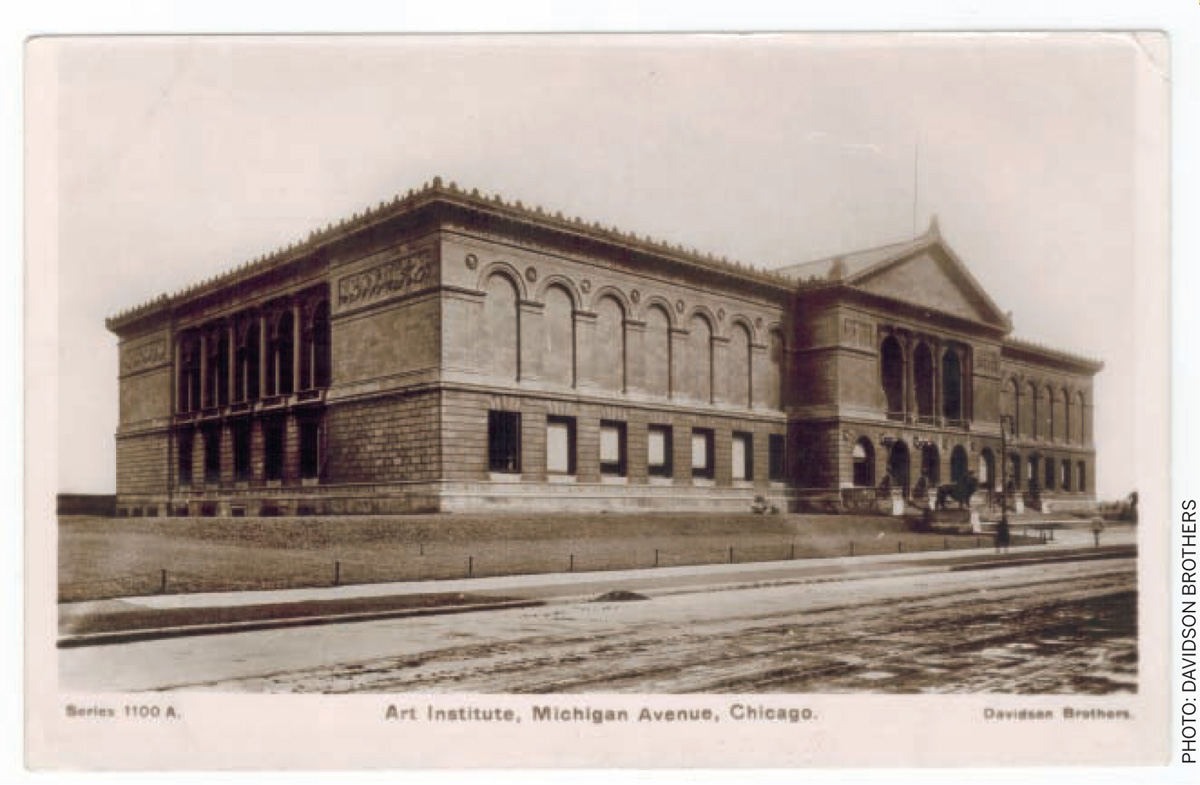
The Art Institute of Chicago is one of the world’s foremost art museums and as such is home to numerous pieces of global heritage. There are the icons: Grant Wood’s American Gothic (1930), Georges Seurat’s A Sunday Afternoon on the Island of La Grande Jatte (1886), and Mary Cassatt’s The Child’s Bath (1893). These are core pieces of global heritage: world-renowned, instantly recognizable works by the most famous of artists. But the world’s story cannot be told with just three pieces of art. The museum is home to many thousands of pieces, from the most well-known paintings and sculptures to sketches for building ornaments and homemade quilts. Each piece plays its part in telling our shared global history – and it is art museums that craft the narrative.
The true value of the display of art is not only found in its individual pieces, but also in the stories that are told through those works. In order for the historical, cultural and political contexts of the artist and their art to be understood by the audience, the work must be framed in a narrative that discusses its placement within a system of critical inquiry. It is these stories, which may encompass discussion of background, analysis and immediate implications that provide concrete takeaways to museum-goers. It is not simply enough to see that American Gothic is technically precise and beautiful; the true value of an art museum lies in framing that piece in a story about its historical context and commentary.
CENTRE OF A COMMUNITY
An art museum is an institution tied to its community that holds a responsibility to educate people – from school children to adults – and build arts appreciation. Both informal and more structured educational experiences are integral to this. The Art Institute of Chicago – from its founding a museum and a school – has dedicated space and effort to developing strong educational content in dynamic ways.
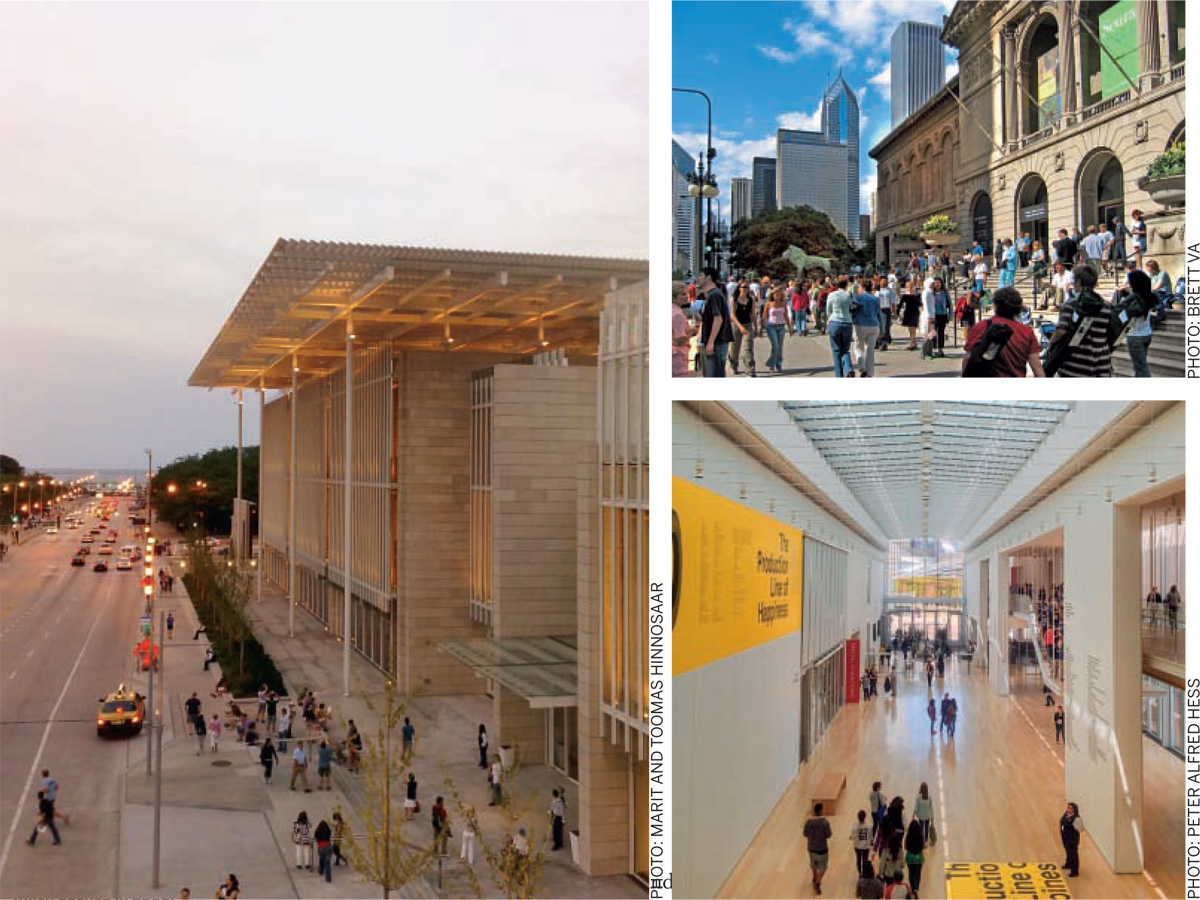
Top Right: The older enterance off Michigan Avenue now sits in the dense built environment of downtown Chicago
Bottom Right: The entryway to the new Modern Wing
The institution’s public programming and learning materials are constantly evolving, as are its public learning spaces. The Ryan Learning Centre, prominently located on the ground floor of the museum’s new Modern Wing, has several interactive spaces, including a Materials Library where visitors can learn about the varied materials available to artists and designers as well as associated craftsmanship techniques. The museum’s Teen Council hosts an annual 24-hour hackathon, ‘RE:Imagine’, where teens ideate on design issues within the museum building and its presentation of art. Topics covered in 2015 ranged from reimagining the gallery bench, the security uniform and wall labels, to the idea of installing an animated GIF gallery. Think of the museum’s recent marketing project for the exhibition ‘Van Gogh’s Bedrooms’ in which a rentable apartment was decorated to look like the artist’s famous bedroom paintings and listed on Airbnb.com. Could this be considered a creative learning experience beyond museum walls?
These examples of museum education programmes integrate analogue and digital tools, a dynamic increasingly important for 21st century museums to recognize and to remain relevant in the future. Further, leveraging the creativity of the public to dive deep into the collection and explore the process of making enables the Museum to demystify the high art that is on display throughout the museum. Leading museums have developed unique ways to dialogue with the public – while it was once innovative to show digital collections and create exhibition-specific websites, the newest approaches, like those the Art Institute is utilizing, are interactive and immersive experiences.
ICON OF LOCAL HERITAGE
Art museums – through their collections and architecture – have come to be icons of the cities where they reside: The Louvre in Paris, the Rijksmuseum in Amsterdam and the Metropolitan Museum of Art in New York are just a few. They are buildings that have evolved through the history of their geographic place to house collections that reflect this history as well.
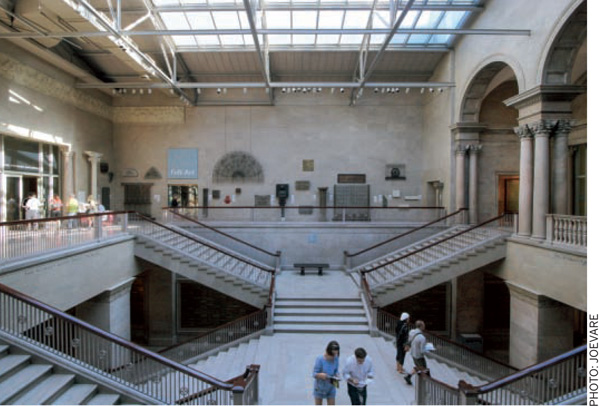 | 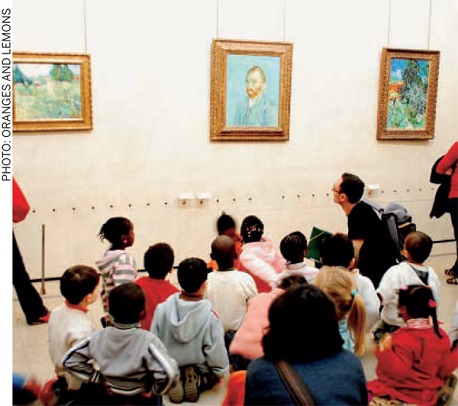 |
The Art Institute of Chicago is no different. The museum has continued to grow through the 20th century and now the 21st, expanding its footprint and updating existing buildings. Visitors might notice consequences of these changes: stairs and ramps, awkward gallery layouts, challenges to handicapped accessibility and varied visibility of artworks resulting from differences in gallery design and lighting.
Each of these features stems from renovation projects and historical approaches to museum gallery design, both of which can alter the way artwork is perceived. For example, the Museum’s original Allerton Building (1893) has glass atrium ceilings, which allow art works to be hung in exact sequence on walls or even stacked, sometimes over-crowding galleries. Subsequent additions, as shown in 1934 proposal drawings for expansion, have windows, which requires objects to be spaced in relation to breaks in the wall, altering the pace and punctuation of galleries.
The scale of impact of these physical elements varies: some changes will be imperceptible to the average person, whereas handicapped accessibility and way finding have become more paramount as the building has been added to. Consider, for example, the Art Institute’s ever-changing floor heights. As each addition was made to the building, not every room’s floor was placed at the same level. This has resulted in the inclusion of several smaller sets of stairs and occasional ramps throughout.
While these likely go unnoticed by most visitors, those who have difficulty with stairs and stroller or wheelchair-bound visitors must work round the building’s architecture to navigate its galleries. This has led to the inclusion of seven different lifts throughout the space to help visitors navigate the various levels.
This difficulty in navigation is not only a logistical conundrum, but it has a direct impact on visitors’ enjoyment of their time at the museum. Future evolutions in the museum’s structure, collections and institutional policies must be planned keeping in mind these key elements of visitor experience.
NARRATOR OF LOCAL HERITAGE
An art museum is inherently a tourist destination. The Art Institute of Chicago regularly features exhibits of local artists, highlights the city’s architecture and has a permanent exhibit examining the city’s public sculptures. Through these exhibits and wide- ranging programming, the Art Institute shares the story of Chicago with the world. Sited in Millennium Park, it is connected to several of Chicago’s tourist districts. Over 50 million tourists visited Chicago in 2014 and nearly a million of them paid a visit to the Art Institute. Each of those visits is an opportunity for the institute to share not only the ‘great works’ with a new audience, but also to share the story of Chicago.
We must not forget that art would go unappreciated and stories would go unheard without visitors.
Into an art museum’s mix of local and global stories comes an equally mixed group of people. There are museum members and art aficionados, out-of-towners and international travelers, occasional local visitors and school groups. Each of these segments has different reasons for coming to the museum and different expectations of what they will get from their visits. A museum should consider each of these user groups when designing and evaluating the visitor experience. Administrators and leaders must understand how museum layout, exhibit design, educational materials, marketing, employee training and other operational factors contribute to the creation of a visitor experience and how that experience can meet the needs and expectations of each person who walks through the door.
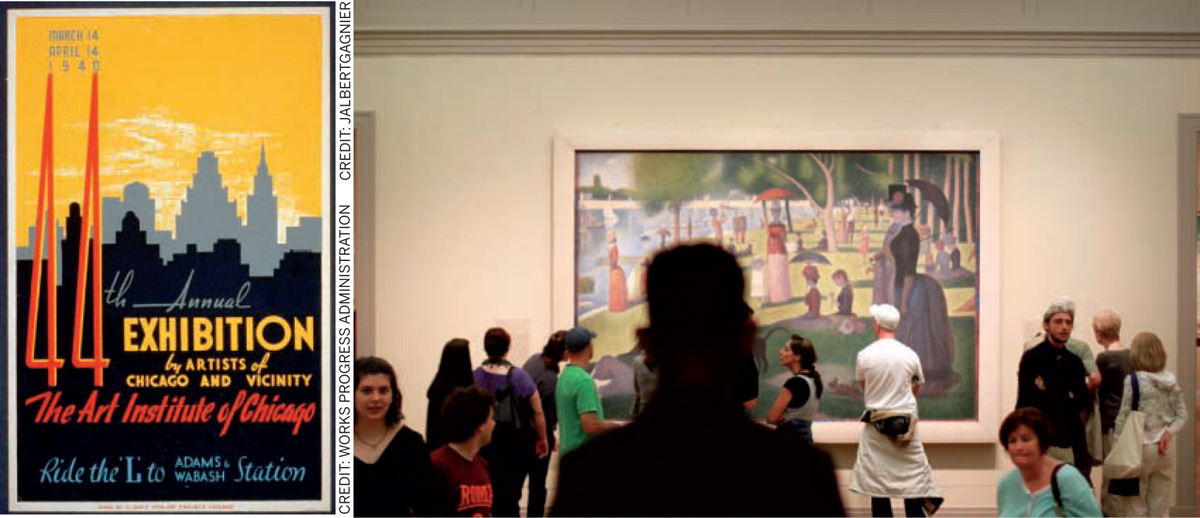
Right: Museum visitors view George Seurat's A Sunday Afternoon on the Island of La Grande Jatte at the Art Institute of Chicago
CURATOR OF FUTURE HERITAGE
As centers of culture and heritage in society, art museums have a responsibility to envision the future of heritage and their role in sharing it with the world. Their role today is not the same as it was a 100, 50, or even 10 years ago. In particular, the museum of the future must focus on its role in its time and its community.
The art museum of the future should leverage its collection to contextualize the present.
Today’s museums tell the story of an artist and their work through the context of their time. By illuminating the narrative behind an artwork, a museum teaches the history of an individual, a community or the world. For example, visitors to Madrid’s Museo Reina Sofia learn of the social and political context and implications of the Spanish Civil War through Picasso’s Guernica, a masterpiece depicting the consequences of human violence. Each object tells a story of the past, with social, political or religious undertones.
The museum of the future will not only tell stories of the past, but challenge visitors to consider the impact of the past on the present. Exhibits of this type use a visitor’s thoughts as an input — local news, the political environment and social debates — and filter them through local and global heritage. By reflecting on the expressions of diverse artists, from the distant past to the present, the exhibit will challenge its visitors to re-examine, reframe and re- evaluate their thoughts and conclusions about the present.
As we have explored, an art museum is unique in its mixture of local and global content and audiences. They are home to the world’s heritage but, at heart, are local institutions. The future of the art museum lies in the expansion of the institution’s role in its community: as not only a center of learning, but also as a center of discourse. As today’s art museums increase their engagement with their local communities, they must respond to the topics and issues that are meaningful to their communities. Through proactive engagement and the facilitation of community dialogue, art museums can grow to be even greater centers of civic life, as well as driving forces in local policy-making and community building.
In a time of technological advancement, globalization and changing generational attitudes, art museums must understand their role in their communities and in the world. Each institution must consider how its unique collection, location and audience come together to facilitate critical thought among its visitors. They must decide how to leverage new technology, changes in attitudes and expectations and new forms of communication to engage their visitors in meaningful discussions about how the stories of the past can inform our attitudes about today and tomorrow. A daunting task, but art museums have conquered such challenges before.



Comments (0)